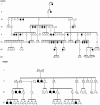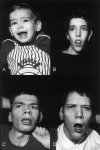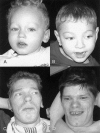Allan-Herndon-Dudley syndrome and the monocarboxylate transporter 8 (MCT8) gene
- PMID: 15889350
- PMCID: PMC1226193
- DOI: 10.1086/431313
Allan-Herndon-Dudley syndrome and the monocarboxylate transporter 8 (MCT8) gene
Abstract
Allan-Herndon-Dudley syndrome was among the first of the X-linked mental retardation syndromes to be described (in 1944) and among the first to be regionally mapped on the X chromosome (in 1990). Six large families with the syndrome have been identified, and linkage studies have placed the gene locus in Xq13.2. Mutations in the monocarboxylate transporter 8 gene (MCT8) have been found in each of the six families. One essential function of the protein encoded by this gene appears to be the transport of triiodothyronine into neurons. Abnormal transporter function is reflected in elevated free triiodothyronine and lowered free thyroxine levels in the blood. Infancy and childhood in the Allan-Herndon-Dudley syndrome are marked by hypotonia, weakness, reduced muscle mass, and delay of developmental milestones. Facial manifestations are not distinctive, but the face tends to be elongated with bifrontal narrowing, and the ears are often simply formed or cupped. Some patients have myopathic facies. Generalized weakness is manifested by excessive drooling, forward positioning of the head and neck, failure to ambulate independently, or ataxia in those who do ambulate. Speech is dysarthric or absent altogether. Hypotonia gives way in adult life to spasticity. The hands exhibit dystonic and athetoid posturing and fisting. Cognitive development is severely impaired. No major malformations occur, intrauterine growth is not impaired, and head circumference and genital development are usually normal. Behavior tends to be passive, with little evidence of aggressive or disruptive behavior. Although clinical signs of thyroid dysfunction are usually absent in affected males, the disturbances in blood levels of thyroid hormones suggest the possibility of systematic detection through screening of high-risk populations.
Figures





Similar articles
-
Clinical course and images of four familial cases of Allan-Herndon-Dudley syndrome with a novel monocarboxylate transporter 8 gene mutation.Pediatr Neurol. 2014 Sep;51(3):414-6. doi: 10.1016/j.pediatrneurol.2014.05.004. Epub 2014 May 9. Pediatr Neurol. 2014. PMID: 25160547
-
Intermittent Esotropia in 4 Patients With Allan-Herndon-Dudley Syndrome.J Child Neurol. 2018 Jul;33(8):525-527. doi: 10.1177/0883073818770597. Epub 2018 May 1. J Child Neurol. 2018. PMID: 29714107
-
Clinical and endocrine features of two Allan-Herndon-Dudley syndrome patients with monocarboxylate transporter 8 mutations.Horm Res Paediatr. 2015;83(4):288-92. doi: 10.1159/000371466. Epub 2015 Apr 15. Horm Res Paediatr. 2015. PMID: 25896225
-
[The importance of thyroid hormone transporters].Nuklearmedizin. 2015;54(3):77-81. Nuklearmedizin. 2015. PMID: 26105714 Review. German.
-
Delayed myelination is not a constant feature of Allan-Herndon-Dudley syndrome: report of a new case and review of the literature.Brain Dev. 2014 Sep;36(8):716-20. doi: 10.1016/j.braindev.2013.10.009. Epub 2013 Nov 19. Brain Dev. 2014. PMID: 24268987 Review.
Cited by
-
Few Amino Acid Exchanges Expand the Substrate Spectrum of Monocarboxylate Transporter 10.Mol Endocrinol. 2016 Jul;30(7):796-808. doi: 10.1210/me.2016-1037. Epub 2016 May 31. Mol Endocrinol. 2016. PMID: 27244477 Free PMC article.
-
The syndromes of reduced sensitivity to thyroid hormone.Biochim Biophys Acta. 2013 Jul;1830(7):3987-4003. doi: 10.1016/j.bbagen.2012.08.005. Epub 2012 Aug 16. Biochim Biophys Acta. 2013. PMID: 22986150 Free PMC article. Review.
-
Clinical phenotype and endocrinological investigations in a patient with a mutation in the MCT8 thyroid hormone transporter.Eur J Pediatr. 2008 Jul;167(7):785-91. doi: 10.1007/s00431-007-0589-6. Epub 2007 Sep 25. Eur J Pediatr. 2008. PMID: 17899191
-
Decreased cellular uptake and metabolism in Allan-Herndon-Dudley syndrome (AHDS) due to a novel mutation in the MCT8 thyroid hormone transporter.J Med Genet. 2006 May;43(5):457-60. doi: 10.1136/jmg.2005.035840. Epub 2005 Jun 24. J Med Genet. 2006. PMID: 15980113 Free PMC article.
-
Role and Clinical Significance of Monocarboxylate Transporter 8 (MCT8) During Pregnancy.Reprod Sci. 2023 Jun;30(6):1758-1769. doi: 10.1007/s43032-022-01162-z. Epub 2023 Jan 3. Reprod Sci. 2023. PMID: 36595209 Free PMC article. Review.
References
Web Resources
-
- Online Mendelian Inheritance in Man (OMIM), http://www.ncbi.nlm.nih.gov/Omim/ (for Allan-Herndon-Dudley syndrome)
References
-
- Allan W, Herndon CN, Dudley FC (1944) Some examples of the inheritance of mental deficiency: apparently sex-linked idiocy and microcephaly. Am J Ment Defic 48:325–334
-
- Bialer MG, Lawrence L, Stevenson RE, Silverberg G, Williams MK, Arena JF, Lubs HA, Schwartz CE (1992) Allan-Herndon-Dudley syndrome: clinical and linkage studies on a second family. Am J Med Genet 43:491–497 - PubMed
-
- Davis JG, Silverberg G, Williams MK, Spiro A, Shapiro LR (1981) A new X-linked recessive mental retardation syndrome with progressive spastic quadriparesis. Am J Hum Genet Suppl 33:A75
-
- Dunn HG, Renpenning H, Gerrard JW, Miller JR, Tabata T, Federoff S (1962–1963) Mental retardation as a sex-linked defect. Am J Ment Defic 67:827–848
Publication types
MeSH terms
Substances
Grants and funding
LinkOut - more resources
Full Text Sources
Other Literature Sources
Medical
Molecular Biology Databases

